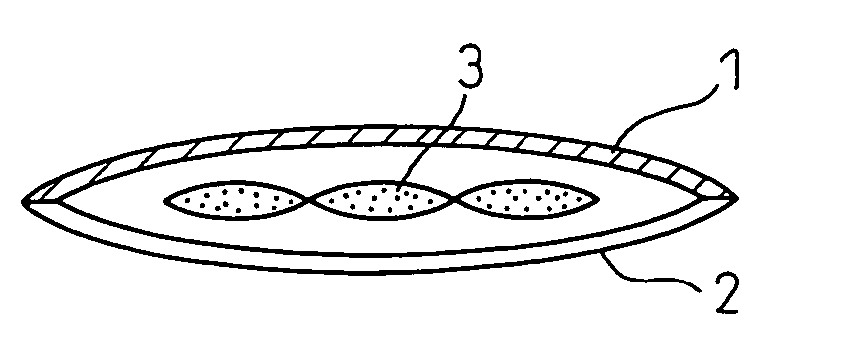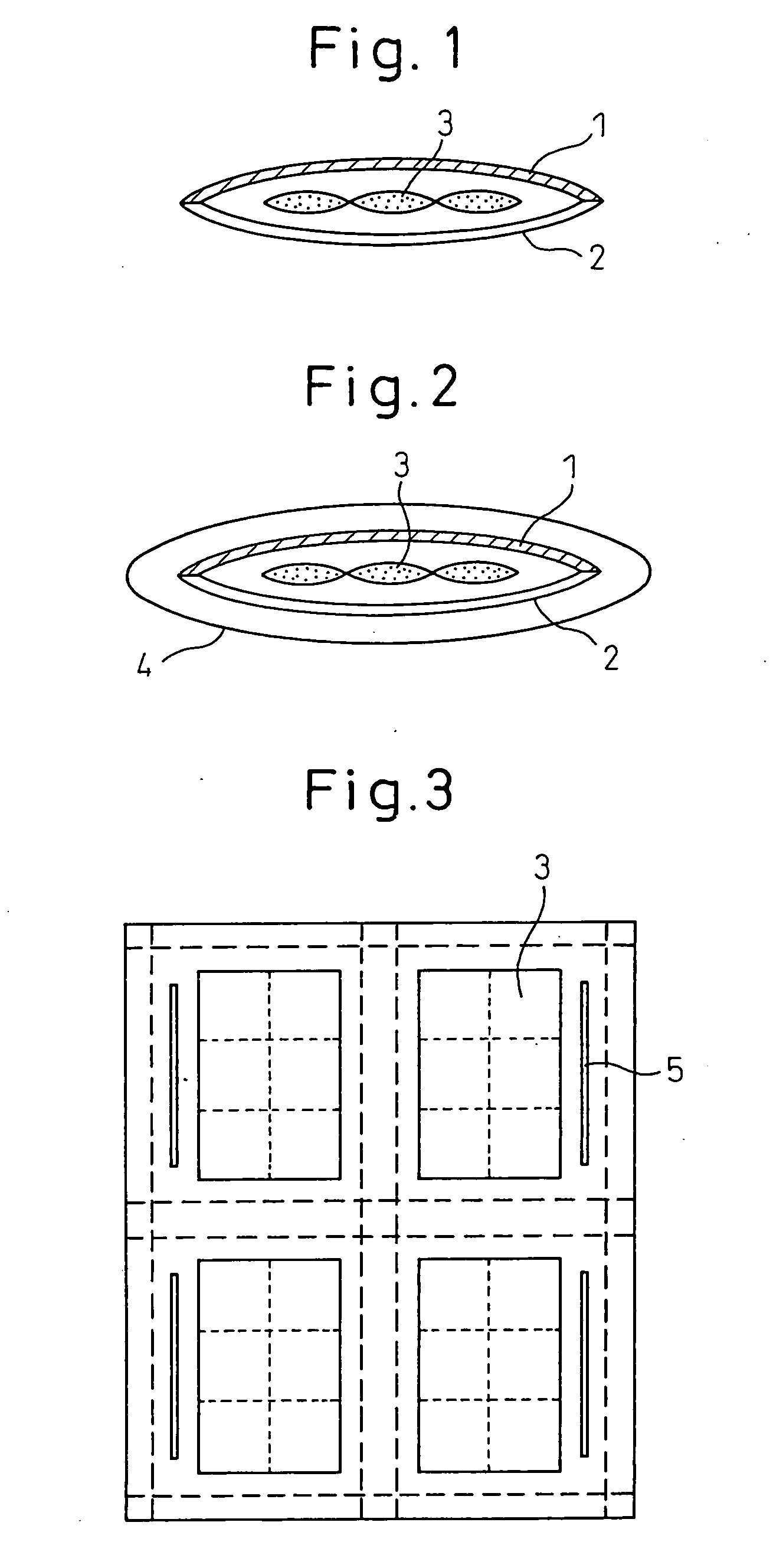Simplified warm-keeping body and warm-keeping cloth
a simple and lightweight technology, applied in the field of light weight, compact and simple warmth retention articles and warmth retention cloths, can solve the problems of inability to warm the human body as a whole, difficult use of sticky exothermic articles at low environmental temperature, etc., and achieve the effects of convenient storage or carrying, low cost, and convenient storage and carrying
- Summary
- Abstract
- Description
- Claims
- Application Information
AI Technical Summary
Benefits of technology
Problems solved by technology
Method used
Image
Examples
example 1
[0083] A nonwoven fabric of a synthetic fiber nylon filaments yarn that was prepared by a known spun bonding method and that had a thickness of 0.22 mm, a fabric weight of 50 g / m2, an average yarn diameter of 16 μm, a void ratio of 80%, a bending resistance of 3.5 cm in the longitudinal direction and 2.3 cm in the transverse direction and a partial thermocompression bonding ratio of 11% was used as a cover material.
[0084] A nonwoven fabric of a synthetic fiber nylon filaments yarn that was prepared by a known spun bonding method and that had a thickness of 0.67 mm, a fabric weight of 100 g / m2, an average yarn diameter of 14 μm, a void ratio of 83%, a bending resistance of 5.4 cm in the longitudinal direction and 3.7 cm in the transverse direction and a partial thermocompression bonding ratio of 5% was used as a heat insulating material.
[0085] A sheet material 90 cm wide and 180 cm long was cut out of the above cover material, and a sheet material having the same dimensions was cut...
example 2
[0088] A nonwoven fabric of a synthetic fiber polyester filaments yarn that was prepared by a known spun bonding method and that had a thickness of 0.15 mm, a fabric weight of 30 g / m2, an average yarn diameter of 14 μm, a void ratio of 86%, a bending resistance of 4.5 cm in the longitudinal direction and 3.8 cm in the transverse direction and a partial thermocompression bonding ratio of 15% was used as a cover material.
[0089] A card web of a polyester short fiber having a fabric weight of 150 g / m2 was laminated to a nonwoven fabric of a synthetic fiber polyester filaments yarn that was prepared by a known spun bonding method and that had a fabric weight of 50 g / m2. The laminated material was mechanically interlaced by needle punching 80 times / cm2 on both sides with a No. 36 regular type needle. The resultant material was used as a heat insulating one. The heat insulating material had a thickness of 3.5 mm, a fabric weight of 200 g / m2, an average yarn diameter of 14 μm and 20 μm, a ...
example 3
[0093] A nonwoven fabric of a synthetic fiber polypropylene filaments yarn that was prepared by a known spun bonding method and that had a thickness of 0.18 mm, a fabric weight of 30 g / m2, an average yarn diameter of 20 μm, a void ratio of 83%, a bending resistance of 4.5 cm in the longitudinal direction and 3.8 cm in the transverse direction and a partial compression bonding ratio of 25% was used as a cover material.
[0094] A nonwoven fabric of a synthetic fiber nylon filaments yarn that was prepared by a known spun bonding method and that had a thickness of 0.25 mm, a fabric weight of 50 g / m2, an average yarn diameter of 13 μm, a void ratio of 87%, a bending resistance of 3.6 cm in the longitudinal direction and 3.2 cm in the transverse direction and a partial compression bonding ratio of 11% was used as a heat insulating material (in addition, a green pigment was added to a nylon polymer (the starting material of the nonwoven fabric) in an amount of 3 wt. %).
[0095] A sheet, 90 c...
PUM
| Property | Measurement | Unit |
|---|---|---|
| thickness | aaaaa | aaaaa |
| thickness | aaaaa | aaaaa |
| thickness | aaaaa | aaaaa |
Abstract
Description
Claims
Application Information
 Login to View More
Login to View More - R&D
- Intellectual Property
- Life Sciences
- Materials
- Tech Scout
- Unparalleled Data Quality
- Higher Quality Content
- 60% Fewer Hallucinations
Browse by: Latest US Patents, China's latest patents, Technical Efficacy Thesaurus, Application Domain, Technology Topic, Popular Technical Reports.
© 2025 PatSnap. All rights reserved.Legal|Privacy policy|Modern Slavery Act Transparency Statement|Sitemap|About US| Contact US: help@patsnap.com


